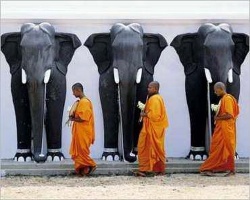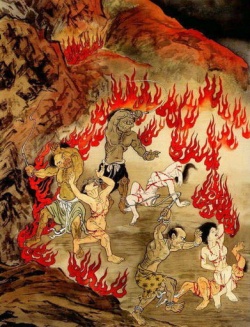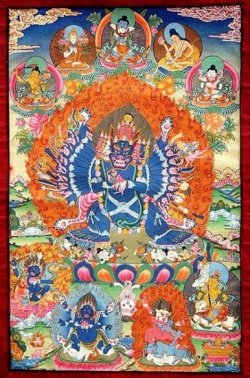The Exegetical Treatises
Before concluding this survey of the Venerable Maha Kaccana's contribution to the Buddha's Dispensation, we should briefly take note that the Theravada tradition ascribes to him two exegetical treatises — the Petakopadesa and the Nettippakarana — and an influential grammar of the Pali language called the Kaccayana-Vyakarana. The two treatises are not included in the Pali canon (except in Burma, where they were lately incorporated into the Sutta Pitaka), but have exerted a major influence on the evolution of exegetical method.
Bhikkhu Ñanamoli, who translated both treatises into English, holds that the Netti is a later, more refined version of the Petakopadesa.[25] Both deal with essentially the same method of exegesis, which in the Netti is clearer and more concise. The method described there is designed to elicit from the Buddha's discourses the unifying principles that underlie the variegated expressions of the Dhamma. It is founded on the assumption that beneath the many diverse utterances of the Master, adapted according to the temperament and situation of the auditors, there runs a single consistent system, which with the right exegetical techniques can be extracted from the particular statement under investigation and displayed in its unadorned essence. The Netti, as Ven. Ñanamoli has explained, is not itself a commentary but a guide for commentators. It explicates, not so much the teachings themselves (except by way of exemplification), but the tools that are to be used to elicit the structural elements that underlie and shape the expression of the teachings.
The Netti sets up its methodology under two main headings, the phrasing (byanjana) and the meaning (attha). The phrasing is handled by sixteen "modes of conveyance" (hara), techniques of verbal and logical analysis that can be applied to any specified passage in order to extract the principles that lie behind the verbal formulation and logical organization of its content. The meaning is handled by three methods or "guidelines" (naya). These take the meaning to be the aim or goal of the doctrine (attha signifies both "meaning" and "goal"), which is the attainment of Nibbana, and they then disclose how the teaching in question points to the attainment of that goal as its underlying purport. Two additional methods are then proposed for correlating the sutta's terminology with the methods for explicating the meaning.[26] The method is applied by the sub-commentaries to the first sutta of each of the four Nikayas in special supplements to the main portion of the subcommentary.[27] A commentary on the Netti, attributed to Acariya Dhammapala, also exists.
The colophons of both exegetical treatises — the Petakopadesa and the Nettippakarana — attribute them to the Buddha's disciple Maha Kaccana. The Netti colophon states further that it was approved by the Blessed One and chanted at the original Buddhist Council. Western scholars have been inclined to dismiss the ascription of authorship to Maha Kaccana as fanciful. Ven. Ñanamoli, however, in the Introduction to his translation of the Nettippakarana, offers an explanation that preserves at least a grain of credibility in the traditional Buddhist view without falling into the opposite extreme of credulity.[28]
Ven. Ñanamoli proposes that we distinguish between the authorship of the exegetical method on the one hand, and the authorship of the treatises on the other. He suggests as a hypothesis — possible though neither provable nor refutable — that the Elder Maha Kaccana and his lineage of pupils in Avanti may have formulated a compendious method for interpreting the Buddha's discourses, and that this method — or at least its elements — may have been discussed at the early Councils and transmitted orally in skeletal form. At a later date, the method could have given birth to a treatise, which attempts to coordinate its elements and to illustrate their application to specific texts. This treatise eventually became the Petakopadesa. Some time later, perhaps even centuries later, a more polished and perspicuous version of the same work was made, this being the Nettippakarana. As the original methodology embedded in these treatises was derived from the Venerable Maha Kaccana, or at any rate was believed to have been derived from him, out of reverence for its architect — and also to boost the prestige of the treatises — their compilers ascribed authorship to the elder. G.P. Malalasekera offers a parallel hypothesis to explain the imputed authorship of the Pali grammar, the Kaccayana-Vyakarana, to the Buddha's great disciple.[29]
While such propositions must remain conjectural, as both Ven. Ñanamoli and Malalasekera themselves acknowledge, the type of detailed analysis of textual statements found in the Nettippakarana is consonant with the approach that the historical Maha Kaccana brought to bear on the interpretation of the Buddha's brief utterances. Thus it would seem that even if no direct connection actually exists between the great elder and the ancient Pali treatises ascribed to him, the fact remains that they embody the spirit that he represented. This spirit, so evident in the suttas that record his elucidations of the Buddha Word, couples acuity of insight with terseness of expression, precision of formulation with profundity of meaning. It was on the basis of such skills that the Enlightened One named him the foremost master of doctrinal exposition, and it is this that constitutes his outstanding contribution to the Buddha's Dispensation.
Notes
1.
The Buddha assigns Maha Kaccana to this position at AN 1: Chap. 14, Etadagga Vagga.
2.
The biographical sketch of Maha Kaccana is taken from the commentary to AN 1: Chap.14, Etadagga Vagga; this is partly paralleled by commentary to Thag., Atthakanipata.
3.
Ap. i,4:3.
4.
Ap. i,54:1.
5.
The offering of the golden brick is mentioned in commentary to AN, Etadagga Vagga.
6.
The account here resumes as in commentary to AN.
7.
His parents' names are mentioned at Ap. i,54:1, v.21.
8.
According to commentary, at the moment the Buddha invited them to join the Order, their hair and beards disappeared and they were spontaneously provided with bowls and robes, created by the Buddha's psychic power.
9.
Vin.i,194-98.The story of Sona is also related at Ud. 5:6, but without the passage on the modification of the monastic rules.
10.
At Vin.ii,299, in describing the preparations for the Second Council, it is said that eighty-eight arahants from Avanti gathered on the Ahoganga mountain slope. They are described as "mostly forest-dwellers, mostly almsmen, mostly rag-robe wearers, mostly wearers of the three robes," and are contrasted with sixty arahant bhikkhus from Pava, all of whom observe these ascetic practices. Though any conclusions drawn from this passage are speculative, these monks may have belonged to the pupillary lineage of Ven. Maha Kaccana, and the reason they were "mostly" observers of the ascetic practices (rather than entirely such) is that he inspired his disciples to undertake such practices by personal example without making them mandatory.
11.
Isidatta is mentioned at SN 41:1, 2. In the first sutta he answers a question on the diversity of elements, a topic that Maha Kaccana also discusses (see below, pp. 29-30); in the second, on speculative views. To escape the fame and admiration which came to him on account of these replies, he disappeared into obscurity.
12.
Dhp. Comy. (to v.94). See E.W. Burlingame, Buddhist Legends (PTS 1969), 2:202-3.
13.
Dhp. Comy. (to v.43). See Buddhist Legends, 2:23-28.
14.
MN Comy. (to MN 108).
15.
Sammaditthi Sutta (MN 9); see The Discourse on Right View (BPS Wheel No. 377/379). Mahahatthipadopama Sutta (MN 28); see The Greater Discourse on the Elephant's Footprint Simile (BPS Wheel No. 101). For a discussion, see Nyanaponika Thera, The Life of Sariputta (BPS Wheel No. 90/92), pp.40-42.
16.
Atthasalini, 16-17. See Life of Sariputta, pp.49-50.
17.
For a detailed study of the term papañca, see Bhikkhu Ñanananda, Concept and Reality in Early Buddhist Thought (Kandy: BPS, 1971). This book contains an insightful discussion of the Madhupindika Sutta, pp.2-9.
18.
MN contains four suttas dealing with the Bhaddekaratta verses, Nos. 131-134. The title phrase is itself a riddle: Ven. Ñanamoli has rendered it "one fortunate attachment," Ven. Ñanananda as "the ideal lover of solitude." But as the word ratta can be taken to mean "night" as well as "attached," the expression may have meant "a single blessed night," referring to the night when insight issues in the attainment of arahantship."
19.
The four viññanatthiti are mentioned at DN 33 (iii,228). See too SN 22:53, 54.
20.
DN 21/ii,283. See Sakka's Quest (BPS Wheel No. 10). The DN text does not include the words settha devamanussanam, "best of gods and humans," appearing in the SN quotation.
21.
See Visuddhimagga, Chaps. IV and V.
22.
Sinhala script and PTS eds. read here adi, though the Burmese script ed. reads assada. The latter reading may be the result of the assimilation of an uncommon reading to the standard formula, in which assada appears in the first place.
23.
This translation is based on K.R. Norman's prose translation of Thag., Elders' Verses, I (PTS 1969).
24.
This verse occurs also as Dhp. 6.
25.
Bhikkhu Ñanamoli's translation of the Petakopadesa is published as The Pitaka Disclosure (PTS 1964); of the Nettippakarana, as The Guide (PTS 1962).
26.
For a discussion of the Netti's methodology, see Ven. Ñanamoli's introduction to The Guide.
27.
For a translation of the Netti analysis of the first sutta of the Digha Nikaya, see Bhikkhu Bodhi, The Discourse on the All-Embracing Net of View: The Brahmajala Sutta and Its Commentaries (Kandy: BPS, 1978), Part 3.
28.
The Guide, pp.xxvi-xxviii.
29.
G.P. Malalasekera, The Pali Literature of Ceylon (1928; reprint Kandy: BPS, 1995), pp.180-82.





